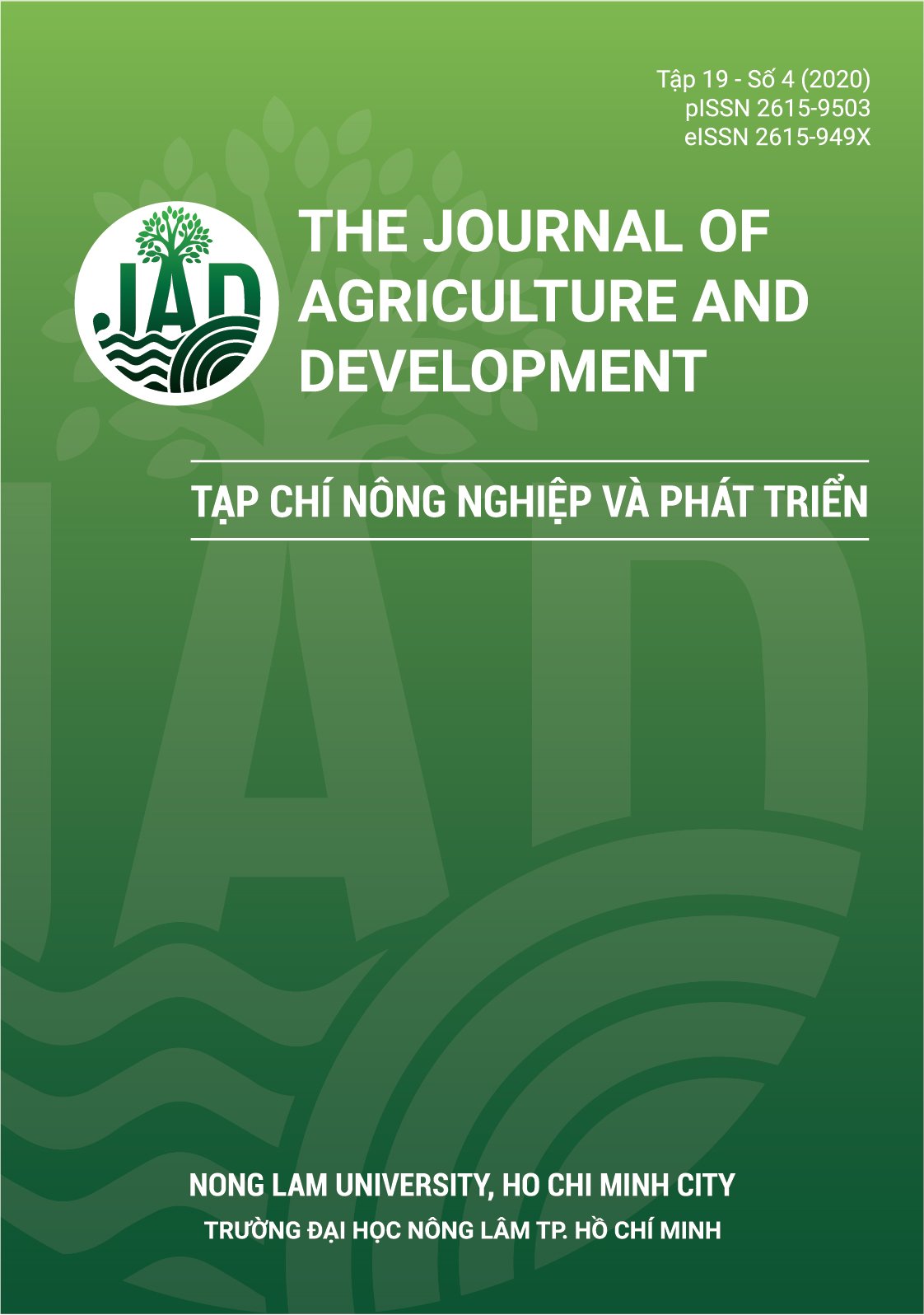Tổng hợp và chuyển cấu trúc RNAi có khả năng bất hoạt gene tuyến trùng sưng rễ (Meloidogyne graminicola) vào cây lúa (Oryza sativa L.)
Main Article Content
Tóm tắt
Các effector có vai trò quan trọng trong quá trình ký sinh của tuyến trùng gây hại thực vật. Phương pháp làm câm lặng các gene mã hóa effector đang được áp dụng để nghiên cứu chức năng và vai trò của effector tuyến trùng. Trong nghiên cứu này, gene Mgra16281 (ID: MK322955.1) mã hóa một effector chưa rõ chức năng được tạo dòng từ tuyến trùng Meloidogyne graminicola ký sinh cây lúa. Từ đó, cấu trúc microRNA nhân tạo có khả năng bất hoạt chuyên biệt gene này được tổng hợp nhờ vào precursor Osa-miR528 của cây lúa. Cấu trúc miRNA nhân tạo được gắn vào vector biểu hiện và chuyển vào cây lúa nhằm tìm hiểu vai trò của effector Mgra16281 thông qua con đường làm câm lặng gene bởi cây chủ (HIGS).
Article Details
Tài liệu tham khảo
Bellafiore, S., & Briggs, S. P. (2010). Nematode effectors and plant responses to infection. Current Opinion in Plant Biology 13(4), 442-448. https://doi.org/10.1016/j.pbi.2010.05.006
Bellafiore, S., Jougla, C., Chapuis, É., Besnard, G., Suong, M., Nguyen, V. P., De Waele, D., Gantet, P., & Ngo, T. X. (2015). Intraspecific variability of the facultative meiotic parthenogenetic root-knot nematode (Meloidogyne graminicola) from rice fields in Vietnam. Comptes Rendus Biologies 338(7), 471-483. https://doi.org/10.1016/j.crvi.2015.04.002
Dutta, T. K., Ganguly, A. K., & Gaur, H. S. (2012). Global status of rice root-knot nematode, Meloidogyne graminicola. African Journal of Microbiology Research 6(31), 6016-6021. https://doi.org/10.5897/AJMR12.707
Eisenback, J. D., & Triantaphyllou, H. H. (1991) Root- knot Nematodes: Meloidogyne species and races. In W. R. Nickle (Ed). Manual of agricultural nematology (191-274). New York, USA: Marcel Dekker.
Gao, L., & Liu, X. (2010). Sporulation of several biocontrol fungi as affected by carbon and nitrogen sources in a two-stage cultivation system. The Journal of Microbiology 48(6), 767-770. https://doi.org/10.1007/s12275-010-0049-2
Golden, A. M., & Birchfield, W. (1965). Meloidogyne graminicola (Heteroderidae), a new species of root-knot nematode from grass. Proceedings of the Helminthological Society of Washington 32(2), 228-231.
Goverse, A., & Smant, G. (2014). The activation and suppression of plant innate immunity by parasitic nematodes. Annual Review of Phytopathology 52, 243-265. https://doi.org/10.1146/annurev-phyto-102313-050118
Gregory, C. B., Marceline, E., & Conrad, B. (2017). The impact of plant-parasitic nematodes on agriculture and methods of control. In: Shah, M. M. (Ed.). Nematology: Concepts, diagnosis and control (121-151). London, UK: IntechOpen. https://dx.doi.org/10.5772/intechopen.68958
Hogenhout, S. A., Van der Hoorn, R. A. L., Terauchi, R., & Kamuon, S. (2009). Emerging concepts in effetor biology of plant-associated organisms. Molecular Plant Microbe Interaction 22, 115-122. https://doi.org/10.1094/MPMI-22-2-0115
Kyndt, T., Fernandez, D., & Gheyse, G. (2014). Plant-parasitic nematode infections in rice: Molecular and cellular insights. Annual Review of Phytopathology 52(1), 135-153. https://doi.org/10.1146/annurev-phyto-102313-050111
Nicol, J. M., Turner, S. J., Coyne, D. L., den Nijs, L., Hockland, S., & Maafi, Z. T. (2011). Current nematode threats to world agriculture. In: Jones, J. T., Gheysen, G., and Fenoll, C. (Eds.). Genomic and molecular genetic of plant nematode interactions (21- 43). London, UK: Springer. https://doi.org/10.1007/978-94-007-0434-3_2
Nguyen, P. V., Nguyen, L. T. N., Tran, T. B., & Ton,L. B. (2019). Construction of artificial microRNA expression vectors for inhibition of Minc16281 gene in root-knot nematode Meloidogyne incognita. The Journal of Agriculture and Development 18(4), 62-69. https://doi.org/10.52997/jad.8.04.2019
Sahoo, K. K., Tripathi, A. K., Pareek, A., Sopory, S. K., & Singla-Pareek, S. L. (2011). An improved protocol for efficient transformation and regeneration of diverse indica rice cultivars. Plant Methods 7(1), 49. https://doi.org/10.1186/1746-4811-7-49
Sambrook, J., & Russell, D.W. (2001). Molecular cloning: a laboratory manual (Vol. 2, 3rd ed.). New York, USA: Helminthological Society of Washington 32(2), 228-231.
Schwab, R., Ossowski, S., Riester, M., Warthmann, N., & Weigel, D. (2006). Highly specific gene silencing by artificial miRNAs in Arabidopsis. The Plant Cell 18(5), 1121-1133. https://doi.org/10.1105/tpc.105.039834
Somvanshi, V. S., Tathode, M., Shukla, R. N., & Rao, U. (2018). Nematode genome announcement: A draft genome for rice root-knot nematode. Meloidogyne graminicola. Journal of Nematology 50(2), 111-116. https://doi.org/10.21307/jofnem-2018-018
Trudgill, D. L., & Block, V. C. (2001). Apomictic, polyphagous root- knoot nematodes: exceptionally successful and damaging biotrophic root pathogens. Annual Review of Phytopathology 39, 53-77. https://doi.org/10.1146/annurev.phyto.39.1.53
Warthmann, N., Chen, H., Ossowski, S., Weigel, D., & Hervé, P. (2008). Highly specific gene silencing by artificial miRNAs in rice. PLoS ONE 3(3), e1829. https://doi.org/10.1371/journal.pone.0001829








